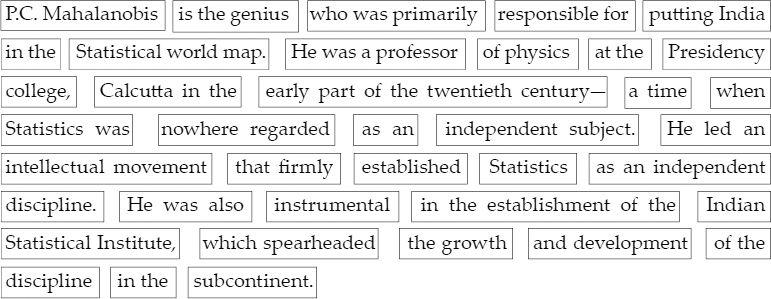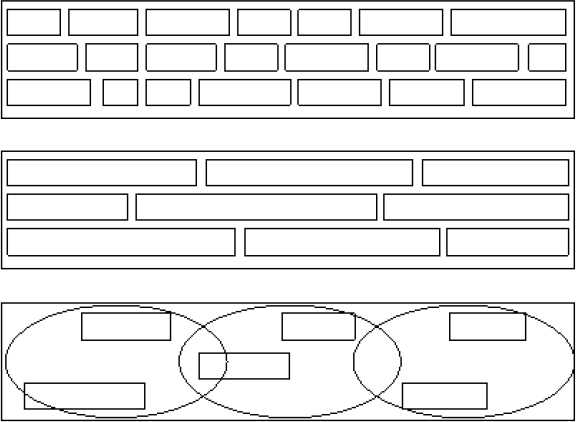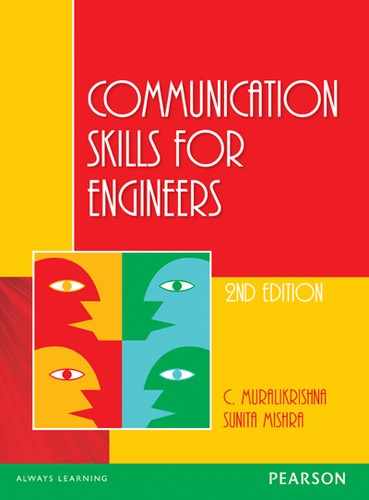CHAPTER 5
Reading Skills
Learning is a means of thinking with another person's mind; it forces you to stretch your own.
— Charles Scribner
Chapter Objectives
This chapter aims to present the basic principles of reading. Its objective is to familiarize the reader with the mechanics of the reading process and its connection with the process of cognition. It also aims to introduce different types of reading, and the situations they can be used in. The chapter also lists out certain techniques like chunking and silent reading that enable fast reading and draws attention to the SQ3R technique.
Very much like the skills of creativity, mind-mapping or negotiation, reading is a skill intimately connected with thinking. It is not simply about gathering meaning by understanding the structures and the vocabulary but also about cognitively processing the ideas, connecting them with one another and finally constructing a meaning from what is ‘given’.
EYE MOVEMENTS AND CHUNKING
When we read anything, we actually rest the eye at places and take in a certain amount of material at a time. We therefore read in jerks. Our eyes can only take in information when they are stopped. So we proceed in a move-stop-read-move-stop-read movement. This can be observed if we look at the eye movement of a person who is reading. The moving and stopping activity of the eye takes about two seconds every time. So the lesser number of movements we have, the lesser time we take to read a certain material. The secret of quick and effective reading is to minimize the number of stops and maximize the number of words one sees at each stop.
ACTIVITY
- Here is a paragraph given below. Check the time you take to read it and also pay attention to the number of eye movements you make in every line.
P.C. Mahalanobis is the genius who was primarily responsible for putting India in the Statistical world map. He was a professor of physics at the Presidency College, Calcutta in the early part of the twentieth century–a time when Statistics was nowhere regarded as an independent subject. He led an intellectual movement that firmly established Statistics as an independent discipline. He was also instrumental in the establishment of the Indian Statistical Institute, which spearheaded the growth and development of the discipline in the subcontinent.
Many of you would have taken in chunks as marked below.

Consciously, try to reduce it to around three stops every line as shown below and try to check the time again. Try to position your eye roughly at the centre of every chunk and extend your vision to the right and the left.

This would certainly reduce the time you take to read. If it does not happen the first time, you can definitely do it with some practice.
Points to Remember
To increase the speed of reading, you should:
- stop looking at every word, one at a time.
- try to take in words in groups,
- deliberately try to increase the number of words taken in at a time, thereby decreasing the number of times w e stop to make meaning of what we are reading.
SPEED READING
With ever-increasing literature in every field, having a good reading speed is inevitable if one is to be fairly acquainted with the developments in the various disciplines of study. A good reading speed is something one cultivates with constant practice. Given below are some of the ways in which this can be done.
1. Reading selectively
Learning to read well is also about learning what not to read. To read fast and to read efficiently, you have to learn what to skip, ignore and choose what to focus on. It is important, therefore, to immediately recognize the key words, identify repetitions or restatements, avoid the structure words or the fillers, make inferences about the meaning and focus on the relevant chunks. This process implicitly involves making a quick mental map of the material to be read so that one can organize the information mentally, get back to the relevant portions when necessary and return easily to the place one had moved from. Effective reading, thus, is not necessarily the act of reading word by word, line after line. More often than not, it is a to--and –fro activity where you move foreword, come back, and proceed once again.
Points to Remember
Important factors while reading are:
- Focusing on key words and ignoring filler words.
- Skipping what you already know.
- Skipping material that does not apply to you.
- Skipping material that seems particularly confusing and coming back to it if necessary after reading other sections
2. Reading without subvocalising.
Like the point discussed above, this is another way of increasing the speed of reading. Often while reading silently, we tend to pronounce the words in our mind. This slows down our reading speed, almost as if we were reading things aloud. This also forces us to read every word, making it impossible to skip or infer. It is necessary, therefore, to consciously stop this method of reading and practice reading and processing with the eyes only. To do this effectively, one has to:
- Move from the “see → say (sub-vocally) → understand” to just “see → understand”.
- Practise taking in semantic chunks at a time and practice what is called “mental reading”.
This habit of taking in larger chunks of material at a time also helps in pulling out words from different lines and synthesizing meaning. Reading, hence, can become simultaneous with thinking, a way of structuring meaning. One of the ways of adapting to multiple reading speeds and styles is to practise to read with the eyes only.
Given below is a picture of three eye-movement patterns showing how reading can be chunked in larger and larger units in the same line and sometimes across lines.

Source: http://braindance.com/bdiread2.htm
ACTIVITIES
- 2. Very quickly gloss through the small passage given below in about 20 seconds. Next, underline the words and sentences you focused on, to quickly get a sense of the meaning. Compare it with the shaded parts of the passage given below.
The study of Mathematics is essential for all children as it has widely ranging application in day-to-day life. The learning of Mathematics at the primary stage provides the child with the basic mathematical concepts and skills needed to tackle real-life problems. It helps to cultivate thinking and reasoning abilities, thereby, strengthens the intellectual underpinnings of social interaction.
The study of Mathematics is essential for all children as it has wide-ranging application in day-to-day life. The learning of Mathematics at the primary stage provides the child with the basic mathematical concepts and skills needed to tackle real-life problems. It helps to cultivate thinking and reasoning abilities, thereby strengthening the intellectual underpinnings of social interaction.
It is quite possible that you too would have swept your eyes across the key words marked to get a sense of the meaning. One has to do this while reading selectively and effectively at the same time.
- 3. Again, read through the paragraph given below and make a note of the semantic chunks that one has to focus on to get a general feel of the content. After reading, identify 10 most important words or phrases that would help one to construct the meaning.
The history of the ancient Egyptian state is one of successive periods of unification and fragmentation. Counterbalancing this, is a pattern of civilization – characterized by such features as the use of writing, an organized system of religion and divine kinship, and dependence on the annual Nile floods for the fertility of the land—which links the different periods together through a span of 3000 years.
With the increasing amount of available information in every field, it has become necessary, in fact inevitable, that selects are information for reading. One way of doing this is to skim through most of the material, select what is important and focus on the necessary information. But this may not be possible in all reading situations. At times one has to read very closely, focus on every word, even read in-between the lines (inferential reading) to get the meaning implied.
- 4. Read the paragraph given below and answer the questions given.
India is a land of ancient civilization that had made fundamental contributions to human knowledge in the ancient past. Even the discovery of the positional number system with the accompanying concept of ‘zero’ is attributed to ancient India. We already have a population of more than a billion and may soon become the most populous nation on Earth. Should we rest content with our ancient heritage and keep repeating that our contribution to knowledge is ‘zero’? Should we continue to be mere borrowers and users of modern knowledge and modern scientific technology? When do we give back? When do we become creators of fundamental knowledge?
- According to the paragraph, the concept ‘zero’ is:
- a part of the positional number system.
- a product of the positional number system.
- connected to the positional number system.
- None of the above.
- Which of the statemets below is most correct?
- The number system is the only contribution India has made to the world.
- Ancient India has made many contributions to the world.
- The contribution of ‘zero’ is the most valuable gift of India to the world.
- None of the above.
- “Should we … keep repeating that our contribution to knowledge is ‘zero’?” what does the word ‘zero’ mean here? Does it have more than one meaning?
- “We already have a population of more than a billion and may soon become the most populous nation on Earth”. Why has this information been given here? How is it linked with the questions that have been posed towards the end of the paragraph?
- What is the meaning of fundamental knowledge? Are there some forms of knowledge that are not ‘fundamental’? Given below are some knowledge fields. How many among them can you consider to be fundamental?
- Astronomical discoveries.
- Different applications of principles of physics in constructions field.
- Knowledge of herbal medicines.
The flood of print has turned reading into a process of gulping rather than savoring.
—Raymond Chandler
In the activities above, you would have inferred that there are various kinds of readings. Depending on the need and the type of material, we decide on a reading mode and proceed accordingly. Most often, we categorize the speed of reading into the following two types:
- Skimming
- Scanning
Skimming is the skill of quickly going through a lot of material to gather the main points. It is necessary to skim when we are trying to get a general idea or sorting out information, trying to check what might be important or even rejecting information as irrelevant. It includes a quick noting of conspicuous text like headings, subheadings, bold or italicized words.
Scanning is done to locate a particular piece of information while going through a general document. It is also done to interpret or reconstruct a pattern in the data presented. We scan while closely examining schedules, meeting plans or train/flight timings. We also scan the index or the bibliographical references when we need certain information. This kind of activity needs close reading and detailed look at information. Sometimes, it might even involve comparison of facts and data presented.
The categorization done above is based on reading speed. There can also be a categorization on the basis of the kind of reading. They are:
- Extensive reading
- Intensive reading
Extensive reading does not focus on particular details but look at ideas and fact patterns. One does extensive reading while looking for a research problem, getting a grasp of work done in a particular field, looking at the trends of publication at a particular time or even reading for pleasure.
Very different from this, is intensive reading. Like scanning, this involves reading to get specific information. But while scanning generally refers to the close checking of lists and tables, this pertains to reading texts and longer material. Intensive reading is done to closely follow a line of argument, read in-between the lines and look for implied positions. Preparation for teaching very often involves intensive reading. It requires paying attention to minute details and understanding detailed facts. Reading for research activity, too, requires intensive reading.
ACTIVITIES
- 5. Look at the following data and state the general theme of the writing. What kind of reading would you like to adopt for this?
In the summer of 1789 the most powerful monarchy in Europe was overthrown by a popular revolution in favour of constitutional rule. There followed ten years of political turmoil as moderate parliamentarians and radical republicans fought over the political future of France. The many different ideals presented by the revolution were impossible to reconcile, and in 1799 a new era of authoritarian rule began under the dashing revolutionary general, Napoleon Bonaparte.
- 6. Given below, are some situations in which we do reading. State what kind of reading you would do in these situations? Remember, depending on your need you would read the same material differently at different points of time. So answer this, given your present condition and necessities.
- The TV guide for the week
- An English grammar book
- An article in a popular magazine about the famous actors of yesteryears.
- The weather report in your local newspaper
- A bus timetable
- A fax that has come for you at the college office.
- An email or letter from your best friend
- A recipe
- A short story by your favourite author
THE SQ3R METHOD
The SQ3R method was put together by Francis Robinson in 1970 as an active and effective method of reading. It is one of the methods best known for reading faster and retaining more. SQ3R stands for the steps in reading: survey, question, read, recite, review. The following are the steps in detail.
Survey
Before reading, survey the material. Look through the main and the sub-headings and try to get an overview. Skim the sections and read the final summary paragraph to get an idea of what the chapter is about. Pay attention to introductory and summary paragraphs and references.
Question
Ask yourself what this chapter is about: What is the question the reading material is trying to answer? Repeat this process with each subsequent section, turning each heading into a question. Asking questions focuses your concentration on what you need to learn or get out of your reading. This step requires conscious effort that it leads to active reading, the best way to retain written material.
Read
Read one section at a time, looking for the answer to the question proposed by the heading. This is active reading and requires concentration. If you finish the section and have not answered the question, reread it. Think while reading. Consider what the author is trying to say, and think about how you can use that information.
Recite
Once you have read an initial section, write down (sometimes in the margins of the book itself) a key phrase that sums up the major point of the section and answers the question. Here, it is important to use your own words, and make your own connections. Research shows that we remember our own (active) connections better than the ones already provided. At this stage, writing down the answers to your questions helps in retaining and consolidating your understanding.
When you read a classic, you do not see more in a book than you did before; you see more in you than there was before.
—Cliff Fadiman
Review
After reading the entire material, again ask yourself the questions that you have identified right at the beginning. Review your notes for an overview of the chapter. Consider how it fits with what you already know. Think of the significance it has in your general learning scheme.
SUMMARY
- Reading is intimately connected with thinking.
- Taking in more material with every eye movement increases the speed of
- reading.
- Reading selectively and reading without subvocalisation are important.
- Learning skimming, scanning, intensive and extensive reading help us adjust the speed and manner of reading according to the material to be read.
- The SQ3R technique is very effective when we need to do active reading for retention as well as understanding.
REVIEW QUESTIONS
- Give a brief account of the different kinds of reading.
- Look around you and make a list of three kinds of material you use for the different kinds of readings.
- What are the different methods one can adopt to practice fast reading?
- Describe the SQ3R technique as an active reading process.

